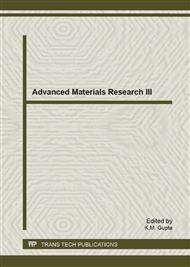p.107
p.112
p.119
p.123
p.128
p.134
p.139
p.145
p.150
Stabilization Studies of Zirconium-Cerium Oxide Nanoparticle-Diesel Suspension
Abstract:
One of the methods for simultaneous improvement of combustion efficiency and reduction of hydrocarbon and nitrogen oxide emissions from diesel engines is the use of catalyst in nanosized form in diesel. Agglomeration of nanoparticles in the base fluid being a serious issue, stability of the nanofluid i.e. the catalytic nanoparticles in diesel is of much concern. In the present work Zr-CeO2 nanoparticles, which acts as storage buffer leading to the reduction of the emissions, were suspended in diesel. The nanofluids were synthesized by two step method and the dosing levels of Zr-CeO2 were varied from 5 to 25 ppm. The surfactant used to improve the stability of the nanofluid was Oleic acid. The optimum concentration of surfactant in diesel fuel was determined as 0.6 percentage by volume in diesel, by the estimation of CMC value of surfactant based on surface tension measurement. The stability of synthesized nanofluids was measured using turbidity meter which shows a good stability for a dosing level of 10 ppm, with minimal settling.
Info:
Periodical:
Pages:
128-133
Citation:
Online since:
April 2013
Authors:
Keywords:
Price:
Сopyright:
© 2013 Trans Tech Publications Ltd. All Rights Reserved
Share:
Citation:


